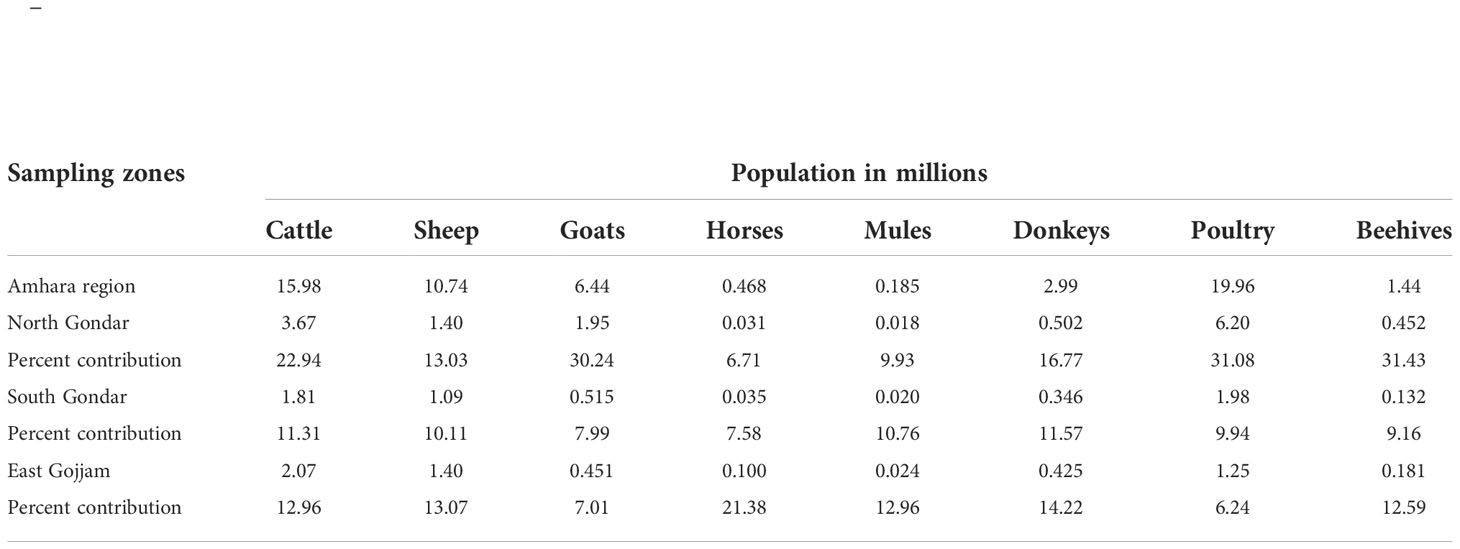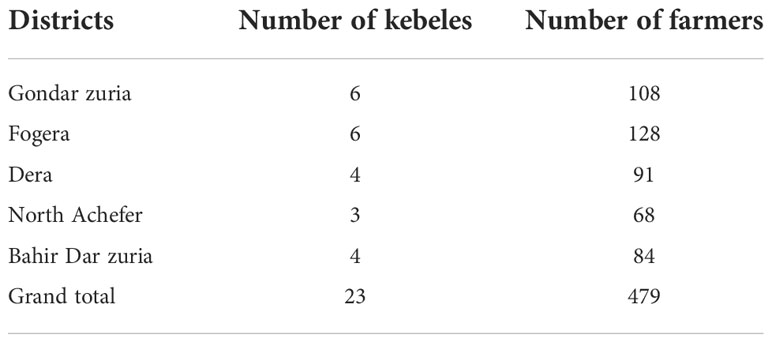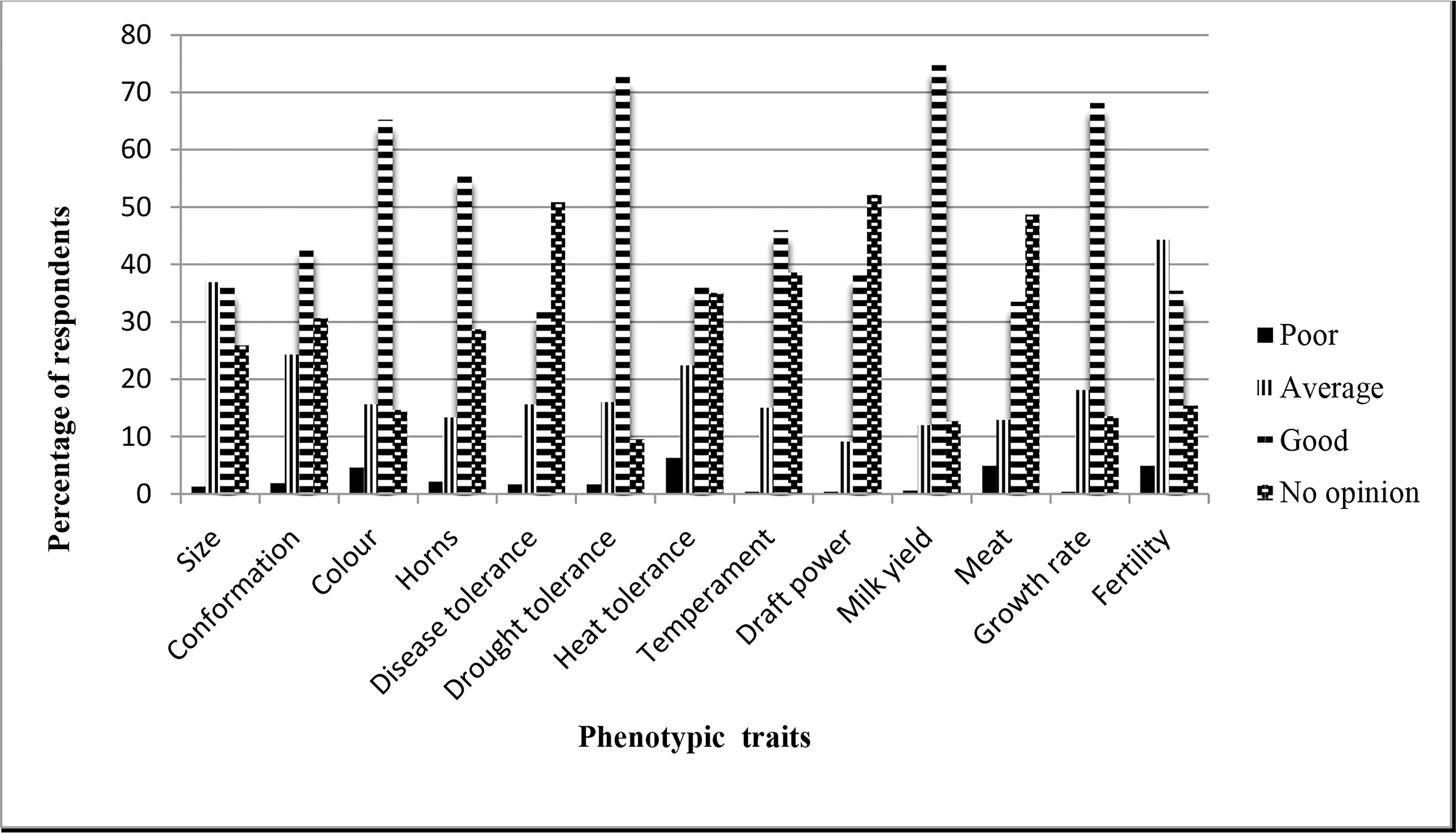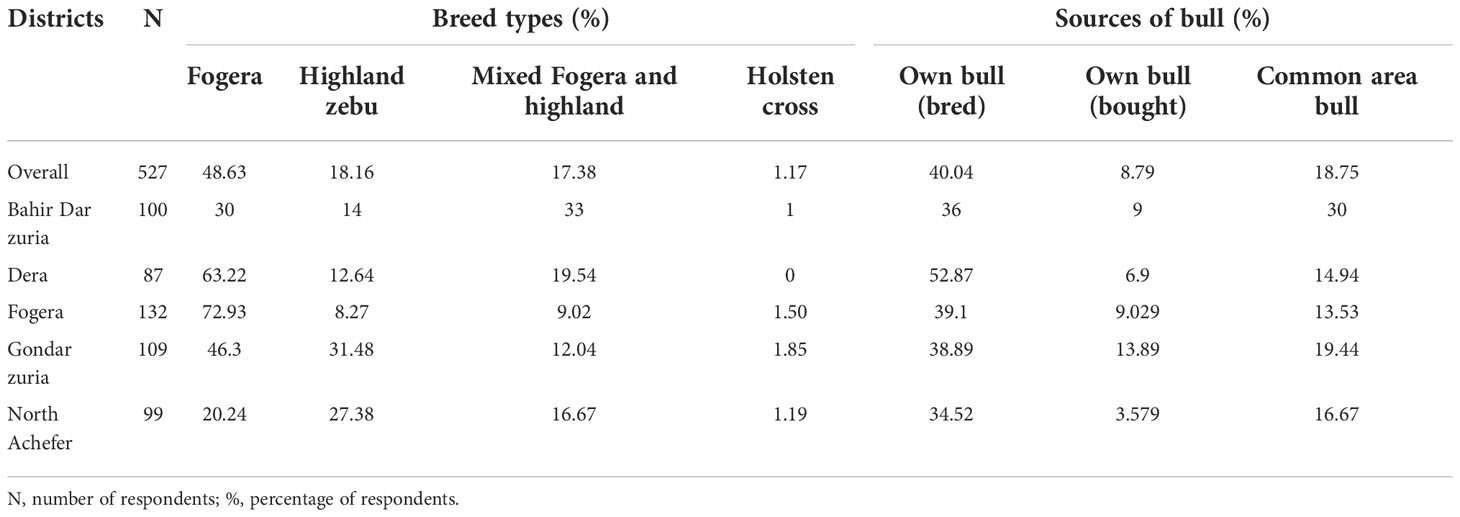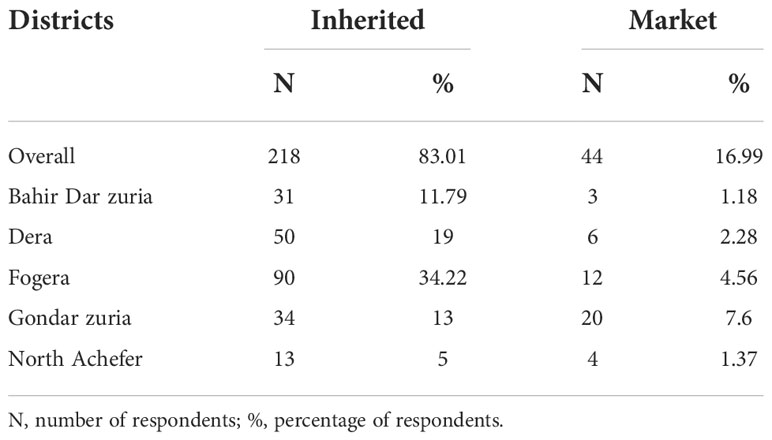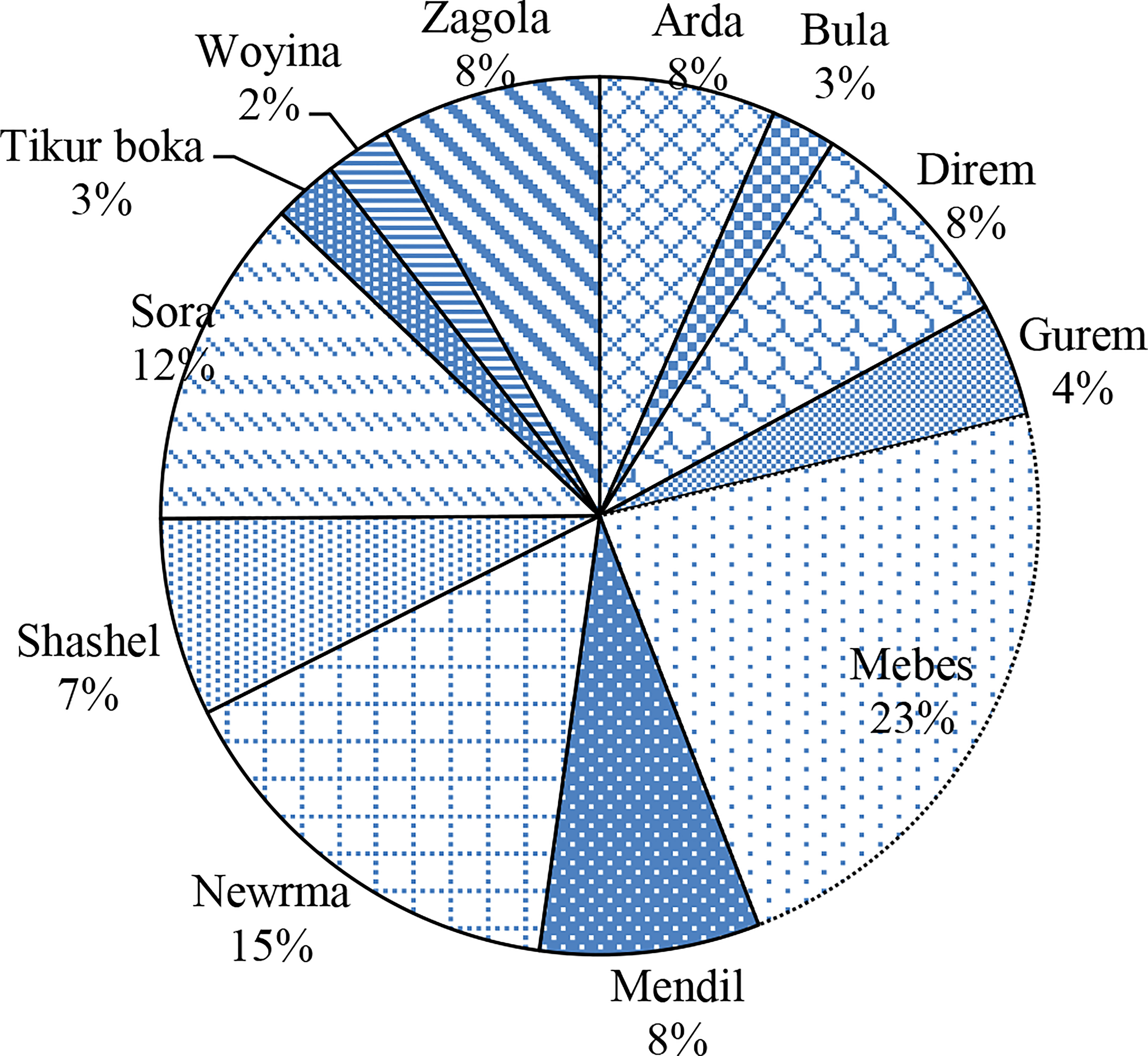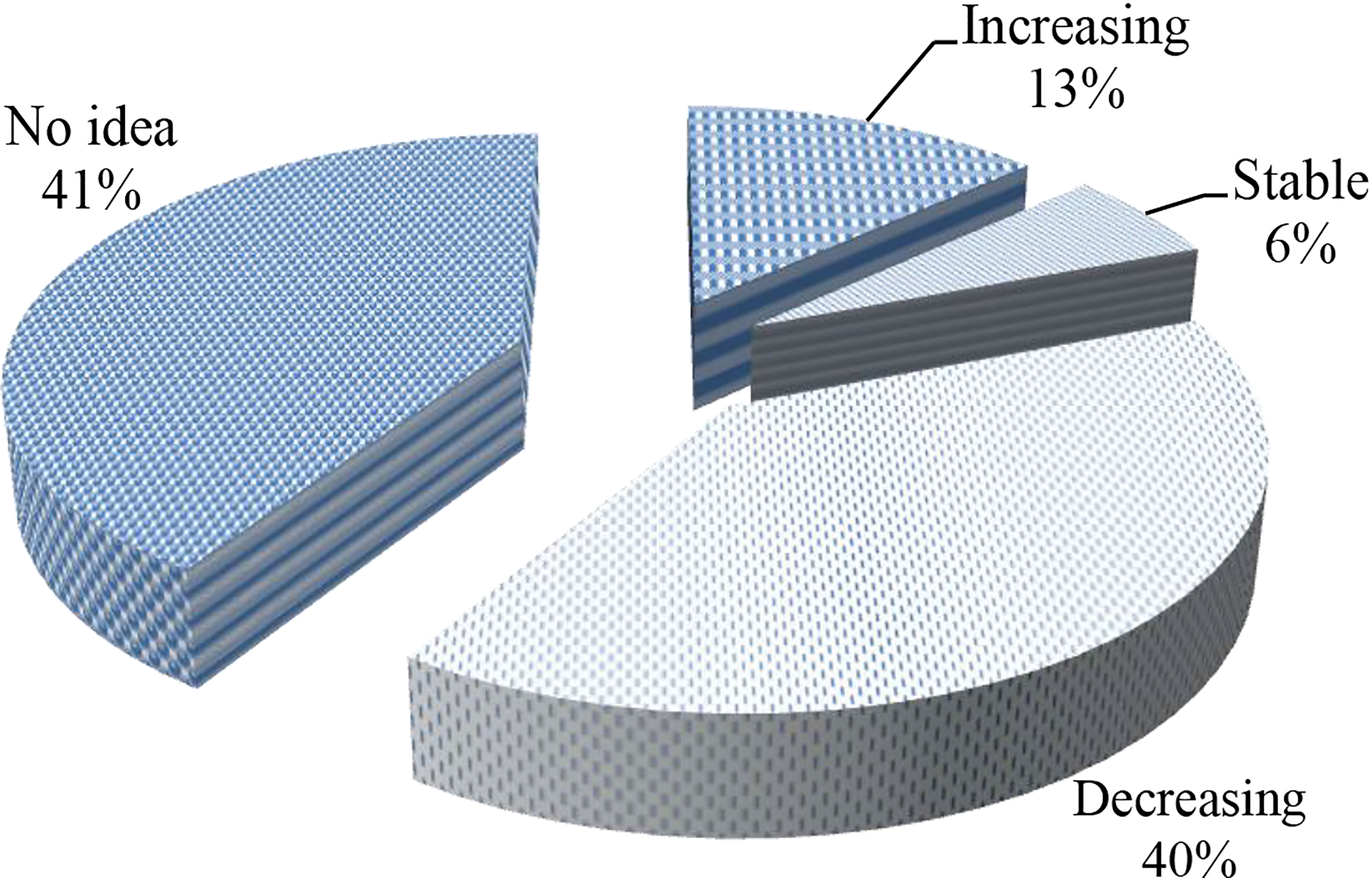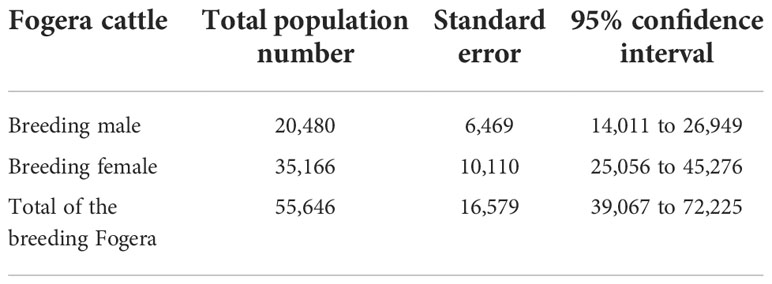- Ruminant Animal Breeding Case Team, Andassa Livestock Research Center, Bahir Dar, Ethiopia
The study was conducted to estimate the population size, herd structure, and breeding objectives of Fogera cattle in Ethiopia. It was carried out in 23 purposively selected kebeles in five districts of three zones bordering Lake Tana. Interviewed farmers were selected based on their livestock ownership. Primary information on the general production system and trends of Fogera cattle was collected from 527 farmers, and a population count included 479 respondents. To differentiate the pure Fogera cattle from the mixed and highland zebu breeds, color photographs of the three breeds were used by each enumerator. Kebele administrators and elders as well as district and zone officials assisted in the operation to identify the true type of Fogera cattle. MS-Excel (2010) and SPSS (version 20) were used to analyze population size and production systems, respectively. The average cattle holding per household was 7.03 ± 0.2 heads. Analysis of multiple responses revealed that the dominant reasons for keeping cattle in the herd were traction power (96.67%), milk (92.76%), and manure (83.95%). More than half of the respondents (64.65%) practiced culling both male and female animals from their herds. Interviewed farmers selected bulls for mating by coat color (56.84%), body conformation (55.08%), and body size (47.46%). They also indicated that they selected the Fogera breed (48.63%), highland zebu (18.16%), and mixed (17.38%) as bulls for mating with their cattle. Based on the respondents’ information, the population trend of the Fogera breed decreases (40%), increases (13%), is stable (6%), and is not known (41%). From the total population estimated, households own the relatively pure Fogera (41%), Fogera–zebu mix (35%), and highland zebu (24%). In this study, the total estimated number of breeding Fogera cattle was 55,646 ± 16,579 heads. It was concluded that the breed has declined and is dealing with genetic deterioration as the population size decreases due to the shift of grazing lands to crop production. As population estimation was performed by morphological features, further research supported by molecular study should be conducted.
1. Introduction
Ethiopia is home to large indigenous cattle populations with diverse breeds, ecotypes, and characteristics (Workneh et al., 2004; Girma et al., 2016). As a result, cattle production for smallholder farmers is one of the main components of agricultural activities in all parts of the country (Endashaw et al., 2015). The vast majority (98.9%) of the national herd in the country is of indigenous cattle maintained in rural areas under extensive husbandry systems (Assemu et al., 2016). These breeds are known for their multiple uses: some are for milk production, some are for meat production, some are fit for traction (draft power), and others are kept for social and cultural purposes.
As current studies have indicated, effective breeding has emphasized a few specialized stocks, and breeds that have been less studied have been at risk of population decline due to neglect of their genetic potential, lack of protection of their genetic diversity, and uncontrolled crossing (Girma et al., 2016). Likewise, because of lack of comprehensive information on population fragmentations or substructures and geographical distributions, many animal populations in the developing regions (including Ethiopia) are commonly referred to as “nondescript” or “traditional.” The inventory of breeds in these regions is thought not to be extensive, and new breeds continue to be identified (Köhler-Rollefson, 2001; Zewdu et al., 2004). In this regard, characterizing the cattle breed as to their population distribution and trend is indispensable.
To date, several cattle breed studies have been conducted in Ethiopia to identify available cattle genetic resources and describe their phenotypic and genetic diversity, husbandry practices, production systems, and breed performance (Ayalew et al., 2004; Endashaw et al., 2015). Likewise, several studies had been conducted on Fogera cattle’s characteristics, specific morphological appearance, and distinctive adaptive features (Alberro and Haile-Mariam, 1982; Rege and Tawah, 1999; Gebeyehu et al., 2004; DAGRIS, 2007). In addition, sufficient information is available on the breed’s productive and reproductive performance under various production and management systems (Addisu and Hegede, 2003; Gebeyehu et al., 2004; Belete et al., 2010; Melaku et al., 2011; Damitie et al., 2015; Girma et al., 2016; Tesfa et al., 2017). Fogera cattle breed appears to be at threat due to changes in the agricultural production system in the area, genetic dilution by interbreeding with other adjacent indigenous cattle breeds, and by indiscriminate crossbreeding with exotic dairy cattle breeds. Population viability analysis indicates that the pure Fogera cattle are not viable, and its population growth is decreasing due to feed shortage, interbreeding with other indigenous breeds, diseases, and parasites (Kefyalew et al., 2015; Tesfa et al., 2017). The estimated population size of Fogera cattle breed has declined progressively from about 800,000 heads in the 1980s (Alberro and Haile-Mariam, 1982) to 15,000 heads in 2004 (Gebeyehu et al., 2004). In addition to the extended report on the population size of the breed, the current production system of the breed’s native area has changed, and has shifted to a mixed agriculture system with rice and vegetable fruit dominated livestock. This system shift has affected the production system and breeding practices of the cattle owners. In addition, the population estimation of a breed has used methodological approaches and sampling size (Alberro and Haile-Mariam, 1982; Gebeyehu et al., 2004), which have followed a direct count of the existing number of animals in a small sample area of the breeds’ distribution area. However, the distribution of the breed was wider, and more effective methods of population size estimations were indicated (John et al., 2003; Workneh et al., 2004; Nyangaga et al., 2005). With this rationale, the current study was initiated to evaluate the breeding practices followed by the farmers and to estimate the current population size of Fogera cattle in Ethiopia.
2 Materials and methods
2.1 Description of the study area
The survey was conducted in five purposively selected districts, viz., Gondar zuria, Fogera, Dera, North Achefer, and Bahir Dar zuria, from three zones of the Amhara region, Ethiopia (Figure 1). All of the selected districts surround Lake Tana as a border on one side. The sample zones were North Gondar, South Gondar, and East Gojjam. As indicated in CSA (2017), all of the sites follow a crop–livestock mixed farming system in which livestock plays a major role in household income and family nutrition. The livestock population of the sampled zones and the contribution share are presented in Table 1.
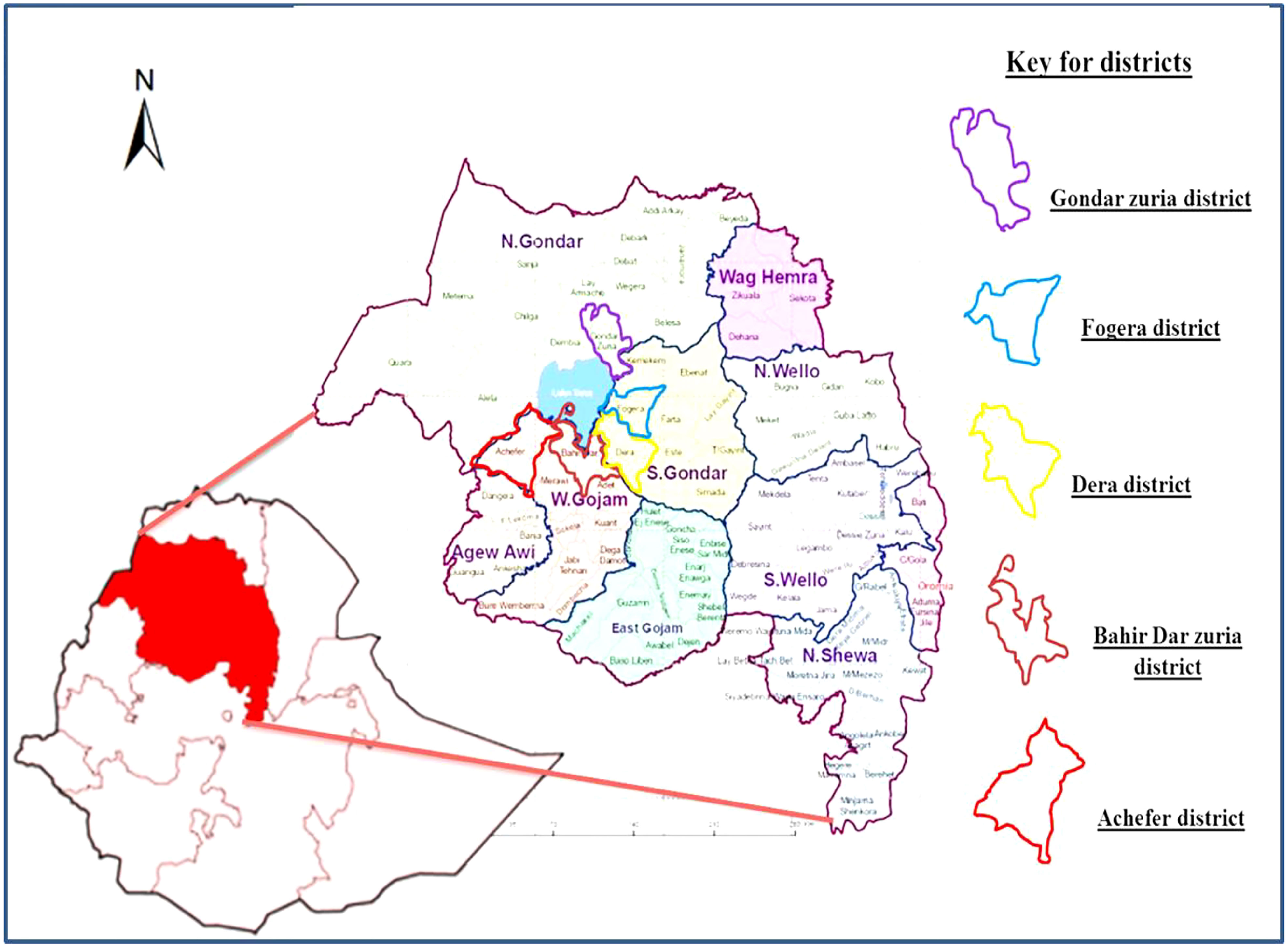
Figure 1 Map of the study districts (Source: Cafer and Rikoon, 2017).
2.2 Description and distribution of the Fogera cattle breed
Ethiopia is home to more than 29 cattle breeds (DAGRIS, 2007), including the Fogera cattle breed that populate and produce mainly in the Amhara region (Addisu et al., 2010). The breed is predominant in the belt of Lake Tana to Abay fall (Figure 2). The breed is characterized and phenotypically well known by its pied coat color of black and white or black and grey (Figure 3); short, stumpy, pointed horns; thoracic to cervico-thoracic hump range; folded and moderate to large dewlap; and docile temperament. The breed is used for draft, milk, and meat (Rege and Tawah, 1999; DAGRIS, 2007). It is highly tolerant to heat stress and solar radiation and is also known for its tolerance to high altitudes, parasite and disease infestation, fly burden, wet soils, and swampy areas. The breed is classified as an intermediate zebu-Sanga type (Zenga type) (Alberro and Haile-Mariam, 1982).
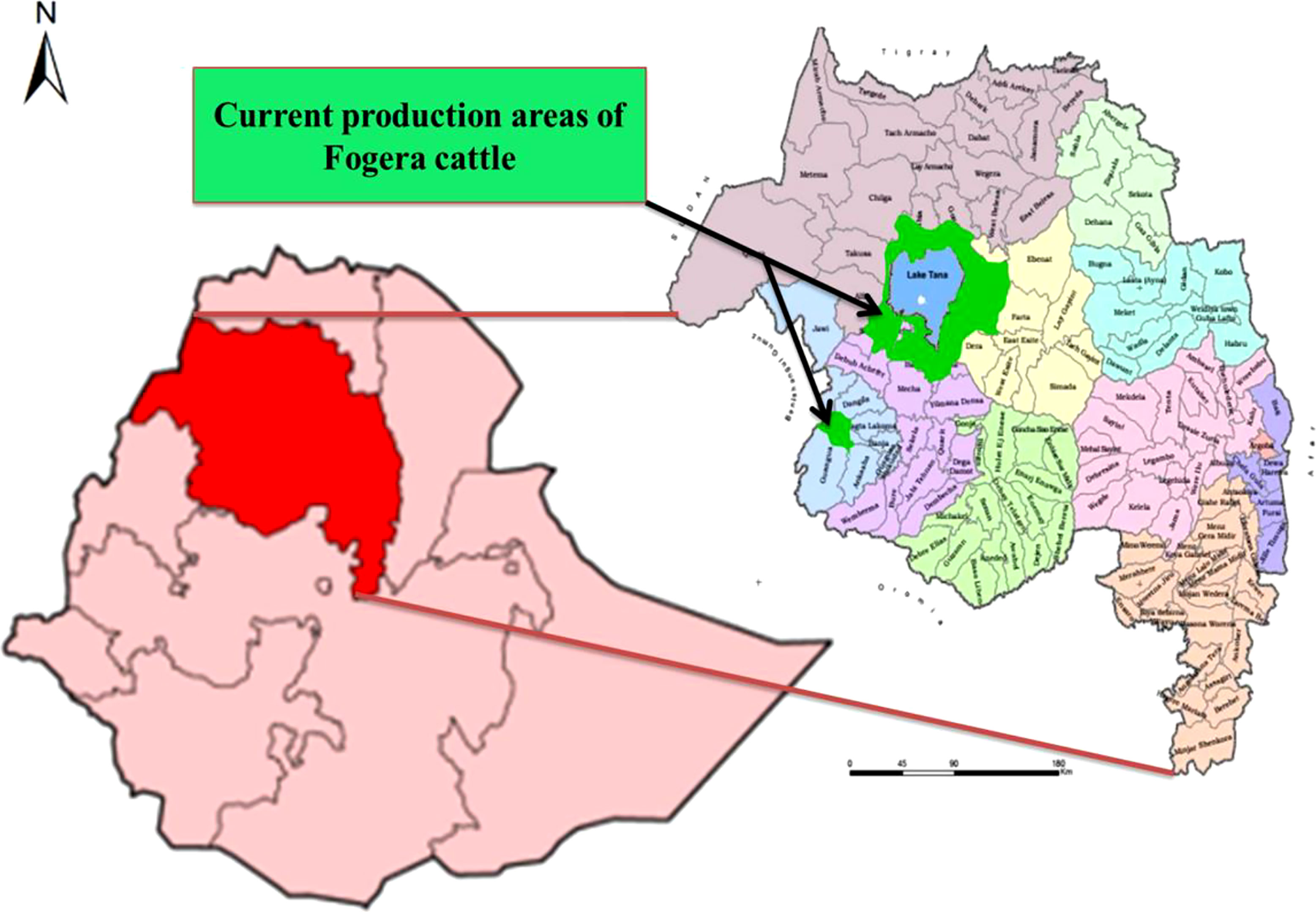
Figure 2 Current production and distribution areas of the Fogera cattle in the Amhara region, Ethiopia (Source: Zelalem et al., 2017).

Figure 3 Fogera cattle heifers (left) and young bulls (right) at the Andassa Livestock Research Center (ALRC).
2.3 Methods of sampling and sample size
The data were collected in two rounds during 2015 and 2016. Study districts were selected based on the available secondary information. With the full involvement of the district experts, study kebeles were selected by stratifying the districts based on the availability of the true type of Fogera cattle: [highly populated (> 80% of the herd resembles Fogera cattle), populated (50%–80%), and less populated (below 50%)]; proximity to Lake Tana (very proximate (up to 1 km radius from the shore of the lake), proximate (1–4 km), and far (above 4 km)); and grazing system (fully grazing and semi-grazing). Based on these strata, a total of 23 kebeles were sampled and used for the survey (Table 2). Similarly, interviewed farmers were stratified based on their wealth status in terms of livestock ownership, viz., rich (having > 10 mature cattle), medium (5–10 mature cattle), and poor (< 5 mature cattle); from the total sampled kebeles, 479 farmers were selected based on equation 1, adopted by Nyangaga et al. (2005).
where
n = The minimum number of sample farmers required in each stratum for a good estimate of the mean number of cattle kept per household
A = The desired level of confidence when estimating the mean number of cattle kept per household. For our surveys, we used 1.96 for the 95% level of confidence.
B = The coefficient of variation
C = The desired level of precision in estimating the mean number of cattle kept per household. For our surveys, we used 20% (i.e., ± 20%) of the population mean.
2.4 Methods of data collection
Primary data directly from farmer interviews and secondary data from published and unpublished documents were used. For the identification of pure Fogera cattle from the mixed and highland zebu breeds, color photographs (Figures 3, 4) were used to guide the enumerators.
The data were collected by six researchers (considered as enumerators) working on the breeding team of the Andassa Livestock Research Center (ALRC), who were able to identify the pure phenotypic feature of the Fogera breed. Kebele administrators as well as district and zone officials assisted in the operation to identify the true type of Fogera cattle.
2.5 Methods of data analysis
2.5.1 Definition of terms
Population: The Fogera cattle breed in a kebele or a district or a zone.
Total: The total number of Fogera cattle in the population.
Mean (µ): The average number of cattle owned per household in the population.
Variance (s2): A measure of the variation in numbers of cattle owned by different households in the population. It is also a measure of variation in cattle population in a kebele.
Standard error (SE): The precision with which the total number of animals is estimated, which is calculated from the variance.
2.6 Methods of data analysis and estimating population size
Assuming that n kebeles are sampled from N kebeles in a district, the sample mean (m) was calculated by adding the number of animals in the sampled kebeles and dividing by n. To obtain the total number of animals in the district, N was multiplied by m. Variance (s2) estimation, standard error, and estimated number of cattle in the district were calculated by equations 2, 3, and 4, respectively, and cluster formation for total number of cattle in a district was estimated by equation 5 (John et al., 2003; Workneh et al., 2004).
To calculate the standard error, calculating variance (s2) from the sample of Peasant Association (PA) is needed and formula (2) was used.
The standard error is the square root of the variance; then
The estimated number of cattle (TC) in the district was then calculated by equation 4.
Clustering of kebele was done for the data collection, and equation 5 was used to estimate the number of cattle in the district (TCD).
The effective population size was determined by equation 6
where Ne is the effective population size, and M and F are the numbers of breeding males and breeding females, respectively.
The index method was adopted to analyze the data collected by the rank method to obtain the average weights of ordinal types of data. The method was based on the weight of each value and multiplying that by the total ranks indicated by equation 7 (Musa et al., 2006).
where
Rn = Value given for the least-ranked level (for example, if the least rank is 5th, then Rn-5, Rn-1 = 4, and … R1 = 1)
Cn = Counts of the least-ranked level (in the above example, the count of the 5th rank = Cn, and the counts of the 1st rank = C1)
In addition, descriptive statistics and weighted averages for multiple responses were analyzed by SPSS for windows (2009). MS-Excel (2010) was also used to calculate the estimated number of Fogera cattle population based on equation 2 to equation 5.
3 Results and discussion
3.1 Herd structure and livestock holding
Based on the current findings, which depend on cattle owners as a source of information, cattle production is dominant throughout the survey districts. The overall cattle holding per household was 7.03 ± 0.2 heads. Poultry holding is the next main livestock sector reared in the study districts, which might be because chickens can be reared by both men and women in households with the lowest initial capital (Table 3). As indicated in the table, the cattle holding of Bahir Dar zuria was higher than the rest of the working districts, mainly due to the availability of grazing land, the production of supplementary forage through irrigation, and also because the selected kebeles of the district had experienced a nomadic nature of cattle production.
3.2 Breeding objectives
The multiple-response analysis indicated that the main breeding objectives of Fogera cattle in the study area were draft power, milk production, and manure, in order of importance (Table 4). Hide production and ceremonial and cultural use were the least important breeding objectives indicated by the respondents. A primary breeding objective for draft power and milk production was also reported by Azage et al. (2009); Donald et al. (2011); Mekonnen et al. (2012); Bayou et al. (2014); Destalem et al. (2015), and Fisahaye (2016). Endashaw et al. (2012) also reported that there were multiple reasons for keeping the Mursi cattle.
3.3 Comparative attributes of the Fogera cattle
Compared to the mixed and highland zebu cattle kept in the same production system, the Fogera cattle had superior quality traits, including greater milk production, drought tolerance, and a better growth rate. Of the overall comparable 13 phenotypic traits, the respondents categorized the Fogera breed as good on eight (61.5%) of them (Figure 5). Milk yield (100%), color (100%), traction power (100%), body size (99.2%), and growth rate (96.8%) were also reported as superior traits of the Fogera cattle (Girma et al., 2016). As reported by Endashaw et al. (2012), farmers of the Bodi area prefer their cattle breed for its better milk production (0.37), adaptability to the local environment (0.17), ability to utilize available feeds (0.15), coat color (0.09), and large body size (0.08). Similarly, reports indicated that the Horro cattle were reared for milk fat content and the Kereyu cattle for milk yield performance (Debir, 2016).
3.4 Culling criteria and reasons for culling of animals
Culling in the production system of cattle is done mainly for maintaining the desired quality of the animals. The main methods of culling are selling, castration, and slaughtering (Debir, 2016). According to the respondents’ responses, they (64.65%) practice culling in their herds. Male animals were culled due to old age (51.76%), individual performance (32.81%), and smaller body size (27.93%) (Table 5), while female animals were culled due to old age (45.7%), poor fertility (41.79%), and individual performance (23.83%) (Table 6). Similar results on culling of animals from the herd by old age, reproductive failure, reduction of production performance, health problems, the need for cash for household use, and slaughter were also reported (Donald et al., 2011; Mulugeta, 2015; Fisahaye, 2016; Girma et al., 2016). There is no significant (p< 0.05) difference between study districts in culling criteria, which might be due to the presence of similar criteria to cull unproductive and inferior animals based on the farmers’ indigenous knowledge.
3.5 Purpose of bull keeping and selection criteria
Of the total respondents, 68.76% keep breeding bulls for breeding purposes (18.75%), draft power (28.91%), and for both breeding and draft power (21.1%). Bull keeping for mating purposes (91.3%) and for both mating and draft purposes (8.7%) was reported (Girma et al., 2016). Multiple-response analysis indicated that respondents use the coat color of the bull (56.84%), body conformation (55.08%), and body size (47.46%) as the selection criteria for breeding bulls (Table 7). The selection criteria for male cattle such as coat color, fertility, body size, horn shape, and its dam’s milk yield were reported by Endashaw et al. (2012). Similar morphological bull selection criteria were also reported by Debir (2016) and Mulugeta (2015). Pedigree performance for bull selection, including milk performance of the dam, mating ability, and fast growth, was reported by Bayou et al. (2014) and Donald et al. (2011).
The majority of respondents (48.63%) indicated that they use selected Fogera bulls for mating their heifers and cows (Table 8). In the Fogera district, 24.81% of the respondents reported that they use selected bulls distributed by the ALRC for community-based conservation and improvement programs. Girma et al. (2016) reported that farmers who kept Fogera cattle practiced pure breeding of Fogera, and interbred with Fogera and non-Fogera types of breeds.
Respondents (40.04%) indicated that their bull source was from their herd (Table 8). Breeding bulls from their source (43.6%) and from neighbors (41.6%) were reported for the Mursi cattle (Endashaw et al., 2012). Keeping their own bulls for mating was also reported by Destalem et al. (2015); Mulugeta (2015), and Bayou et al. (2014).
3.6 Type of mating and source of mating bulls
Respondents followed group mating (38.87%), hand mating (28.52%), and uncontrolled mating (22.27%) in their herds (Table 9). Group mating is conducted when the farmer selects a breeding bull and lets the herd stay with the selected bull for mating; hand mating is conducted when the farmer selects a bull and lets the cows mate individually; and uncontrolled mating is done on the grazing land. Similar results of hand mating and uncontrolled mating with 55.4% were reported by Endashaw et al. (2012). Unlike the current findings, Bayou et al. (2014) reported uncontrolled mating as a major mating system.
3.7 Status of the Fogera cattle breed
3.7.1 Sources of the Fogera cattle breed
The respondents indicated that the source of Fogera breed was from their family (inherited) (83.01%), and the remaining (16.99%) sources were by purchasing from selected markets (Table 10). This result is consistent with the reports of Addisu et al. (2007), who indicated that 73% of the Fogera cattle originated from their source (inherited from their family). Those farmers bought Fogera cattle at the market, indicating that the central market for Fogera breed was the Yefag market in the Libokemkem district.
3.7.2 Local naming of the Fogera cattle breed
Fogera cattle breeds have been given different local names by their keepers based on variations in their coat color, body shape, nature of backline, and presence of unique body marks and spots. In all the study districts, these names are common and similar for the breed. More than 12 coat colors have been reported, with dominance of Mebes1 (23%), Newurema 2 (15%), and Sora3 (12%) (Figures 6, 7). In his study, Assemu (2015) indicated that these coat color variations also showed a significant (p< 0.05) difference in the production and reproductive performance of the breed. Girma et al. (2016) also reported that these three colors for the Fogera breed were repeatedly reported by farmers. Donald et al. (2011) reported more than 60 local names for the Ankole cattle based on body coat color and/or pattern; horn shape, size, and orientation; hump size; navel size; ear form; head size; tail shape; and body length.
1a color with black being dominant, having white at the back and bottom of the body
2a color with white being dominant, having black spots
3a color of white and red mixed throughout the body
3.7.3 Population trends of the Fogera cattle breed
Respondents and experts of the study districts and kebeles indicated that the Fogera cattle show a declining trend (Figure 8) in terms of their population and genetic merit. The main reason for this was the paradigm shift in the farming system from a mixed production system to a rice-dominant production system at the expense of extensive grazing lands. Degradation and coverage of the grazing land by invasive and noxious weeds, genetic admixture, and lack of labor were also given as reasons by the respondents. Similar reasons for the declining trend of the Fogera cattle were also reported by Addisu et al. (2007) and Assemu (2015). A declining trend in population was also reported for the Begait cattle (Mulugeta, 2015) and Horro cattle (Mekonnen et al., 2012), and a very high population reduction trend was reported for the Sheko breed (Tatek and Abegaz, 2013; Getinet and Adebabay, 2015). In the current study, we also report similar reasons for the declining trend of the breeds.
3.8 Current population size of the Fogera cattle breed
The population count of Fogera cattle was performed using the three categories of pure Fogera, mixed Fogera, and highland zebu breeds. From the total population estimated in the study districts, households own 41% relatively pure Fogera, 35% Fogera–highland zebu mix, and 24% highland zebu based on the breeds’ phenotypic features. In total, 76% of the estimated population was reported to have Fogera blood. This report is much lower than what was reported by Addisu et al. (2007), who stated that 98.1% of the respondents in northwest Ethiopia include Fogera cattle in their herds. This might be because some additional sites were considered in this study compared to the sites covered by these authors. It might also be due to the increased transhumance of the Fogera breed to the highland areas and in turn, crossing with highland zebu cattle during the rainy season to escape inundation of the plain by Lake Tana. In addition, the preference of highland zebus by the farmers over Fogera (due to high feed requirement) might also imply the decline in the ownership trend of Fogera cattle from the general perspective.
In this study, the total estimated number of the breeding Fogera cattle was 55,646 ± 16,579 heads, and the effective population size (Ne) of the breed was 51,770 heads (Table 11). The literature reported that the population size of the Fogera breed decreased at an alarming rate from 800,000 in 1981 (Alberro and Haile-Mariam, 1982), 636,000 in 1998 (ILRI, 2007), and 86,800 in 1999 (Rege and Tawah, 1999) to 15,000 in 2004 (Gebeyehu et al., 2004). However, the current population size shows an increase compared to the last report. The increase might be due to the adoption of a better estimation methodology and wider sampling size and area coverage. The higher number reported by Alberro and Haile-Mariam (1982) considers the entire cattle population count in one district (Fogera district) where the breed is produced, and the study by Gebeyehu et al. (2004) reported the population of selected kebeles of two districts, viz., Fogera and Dera. However, due to the increased distribution of the breed (Figure 2) and the transhumance by herders, the current paper covered five districts and followed a systematic breed population count methodology, which increased the current population size of the breed. Despite higher figures reported in this study than Gebeyehu et al. (2004), the population trend of the breed continues to decline.
According to the current estimation, the Fogera–highland zebu cross of different blood levels also covered 35% of the total cattle population in the study districts, creating a pressing need to back-cross to 100% Fogera blood levels through the introduction of pure Fogera breeding bulls. In line with this, important activities are being undertaken by the ALRC to increase the number of Fogera cattle through community-based bull service, which needs further scale-up.
4 Conclusion and recommendations
● Based on the farmers’ responses and the current population size, it can be concluded that the breed has declined and lowered its production and productivity. According to the current estimation, Fogera–zebu crossbreeds of different blood levels covered 35% of the total cattle population, which calls for a pressing need to back-cross to pure Fogera blood levels through the introduction of pure Fogera breeding bulls.
● The Fogera breed has a wide distribution in the region expanding from Lake Tana to Abay fall; this distribution faces interbreeding and genetic admixture that requires community-based conservation and improvement of the breed to upgrade the pureness of mixed Fogera for sustainable utilization of the breed’s present and future merit.
● As indicated here, the breed’s merits are well acknowledged by the farmers, and need the government’s input on conservation and improvement strategies.
● The current breed estimation was carried out based on its morphological features, so further molecular studies should be conducted to estimate the population number of the true-to-type Fogera cattle.
Data availability statement
The raw data supporting the conclusions of this article will be made available by the authors, without undue reservation.
Ethics statement
The animal study was reviewed and approved by the Livestock office of the Amhara region.
Author contributions
AT contributed to the data analysis and writing of the original draft of the article. TB, MT, and DK contributed to the project development, data collection, and development of the draft with the corresponding author. AK and WM contributed comments on the draft paper. All authors have read and approved the final manuscript.
Funding
The funding for this work was provided by the Ethiopian Nile Irrigation and Drainage Project (ENIDP) and the Amhara Agricultural Research Institute (ARARI).
Acknowledgments
The Ethiopian Nile Irrigation and Drainage Project (ENIDP) is recognized by the authors for its collaboration and financial support. The authors express their heartfelt gratitude to all the district livestock process owners, experts, and development agents (DAs) who supported the selection of representative study sites and respondent farmers. Respondent farmers are also duly acknowledged for their valuable assistance in the primary data collection. The authors wish to express their appreciation of Wondemagegn Mengesha, Wondemeneh Mekonnen, Taddese Getu, and Endalew Belie for their participation in the data collection and data entry. We also acknowledge Eyasu Zeleke and Yibeltal Meselu for the transport arrangement and for driving us through the entire rough road.
Conflict of interest
The authors declare that the research was conducted in the absence of any commercial or financial relationships that could be construed as a potential conflict of interest.
Publisher’s note
All claims expressed in this article are solely those of the authors and do not necessarily represent those of their affiliated organizations, or those of the publisher, the editors and the reviewers. Any product that may be evaluated in this article, or claim that may be made by its manufacturer, is not guaranteed or endorsed by the publisher.
References
Addisu B., Adebabay K., Bewuket S., Solomon G., Tewodros B. (2010). “Conservation-based breeding program for fogera cattle,” in Working document (Amhara Regional Agricultural Research Institute Andassa Livestock Research Center).
Addisu B., Getinet M., Tezera M. (2007). “On-farm evaluation of management practices and productivity of fogera cattle in Northwest Ethiopia,” in Proceedings of the 2nd annual regional conference on completed livestock research activities, Bahir Dar, Ethiopia (Amhara Regional Agricultural Research Institute (ARARI). Available at: http://www.arari.gov.et/index.php/documents.
Addisu B., Hegede B. P. (2003). “Evaluation of reproductive and growth performance of fogera cattle and their F1-friesian crosses at metekel ranch, Ethiopia,” in Proceedings of the 10th annual conference of the Ethiopian Society of Animal Production (ESAP) held in Addis Ababa, Ethiopia, Addis Ababa. 119–126 (ESAP). Available at: https://esap-ethiopia.org.et.
Alberro M., Haile-Mariam S. (1982). “The indigenous cattle of ethiopia. part-I,” in World animal review, 41, 2–10. Available at: https://hdl.handle.net/10568/66903.
Assemu T. (2015). Estimation of genetic and non genetic parameters for growth and reproductive performance traits of fogera cattle breed (Bahir Dar, Ethiopia: Bahir Dar University College of agriculture and environmental science).
Assemu T. S., Dilip K., Solomon A., Getinet M. (2016). Evaluations of reproductive performances of fogera cattle breed in selected districts of amhara region, Ethiopia. Int. J. Pharma. Med. Biol. Sci. 5 (1), 52–57. doi: 10.18178/ijpmbs.5.1.52-57
Ayalew W., Getahun E., Tibbo M., Mamo Y., Rege J. E. O. (2004). Current state of knowledge on characterization of farm animal genetic resources in Ethiopia. Proc.11th Annual conf. Ethiopian Soc. Anim. Prod. pp. 1–22.
Azage T., Tesfaye M., Tesfaye D., Worku T., Eshete D. (2009). “Transhumance cattle production system in north gondar, amhara region, Ethiopia: Is it sustainable?,” in IPMS (Improving productivity and market success) of Ethiopian farmers Project.Working paper no. 14 (Nairobi, Kenya: ILRI (International Livestock Research Institute), 73.
Bayou E., Haile A., Gizaw S., Mekasha Y. (2014). Characterizing husbandry practices and breeding objectives of sheko cattle owners for designing conservation and improvement strategies in Ethiopia. Livest. Res. Rural Dev. 26 (12), 235.
Belete A., Azage T., Fekadu B., Berhanu G. (2010). “Cattle milk and meat production and marketing systems and opportunities for market-orientation in fogera woreda, amhara region, Ethiopia,” in IPMS (Improving productivity and market success) of Ethiopian farmers project working paper 19, vol. 65. (Nairobi, Kenya: ILRI (International Livestock Research Institute).
Cafer A., Rikoon S. (2017). Coerced agricultural modernization: A political ecology perspective of agricultural input packages in south wollo, Ethiopia. J. Rural Soc. Sci. 32 (1), 77–97.
CSA (Central Statistical Agency) Federal Democratic Republic of Ethiopia (2017). “Agricultural sample survey 2016/17 [2009 E.C.],” in Report on livestock and livestock characteristics (Private peasant holdings), vol. Volume II. Available at: https://www.statsethiopia.gov.et/language/am.
DAGRIS (2007). Domestic animal genetic resources information system (DAGRIS). Eds. Kemp S., Mamo Y., Asrat B., Dessie T. (Addis Ababa, Ethiopia: International Livestock Research Institute ILRI). Available at: http://dagris.ilri.cgiar.org.
Damitie K., Kefyalew A., Endalkachew G. (2015). Reproductive and productive performance of fogera cattle in lake tana watershed, north Western amhara, Ethiopia (Biotechnology Research Institute, Ethiopia: Bahir Dar University).
Debir L. B. (2016). A review on dairy cattle breeding practices in Ethiopia. J. Biol. Agric. Healthc. 6 (7), 121–128.
Destalem G., Berhanu B., Azage T. (2015). Assessment of breeding practice of dairy cattle in the central zone of tigray, northern Ethiopia. J. Biol. Agric. Healthc. 5 (23), 96–105.
Donald R. K., Nabasirye M., Hanotte O., Mpairwe D., Okeyo A. M. (2011). Pastoralists' indigenous selection criteria and other breeding practices of the long-horned ankole cattle in Uganda. Trop. Anim. Health Prod. 44, 557–565 doi: 10.1007/s11250-011-9935-9
Endashaw T., Tadelle D., Aynalem H., Wudyalew M., Okeyo M. (2012). Husbandry and breeding practices of cattle in mursi and bodi pastoral communities in southwest Ethiopia. Afr. J. Agric. Res. 7 (45), 5986–5994. doi: 10.5897/AJAR12.1566
Endashaw T., Tadelle D., Aynalem H., Wudyalew M., Okeyo M. (2015). On-farm phenotypic characterization of mursi cattle in its production environment in south omo zone, southwest Ethiopia. Anim. Genet. Resour. 2015, 1. doi: 10.1017/S2078633615000132
Fisahaye A. W. (2016). Indigenous livestock husbandry and ethno veterinary practices in endamohoni district of tigray region, Ethiopia (Hawassa, Ethiopia: Hawassa University).
Gebeyehu G., Azage T., Tezera M., Aklilu A. (2004). “Preliminary report on the distribution of fogera cattle around lake tana, ethiopia”, Farm animal biodiversity in Ethiopia: Status and prospects in Proceedings of the 11th annual conference of the Ethiopian Society of Animal Production (ESAP), Addis Ababa, Ethiopia, (Ethiopian society of Animal production (ESAP)) Vol. 2004. 203–207.
Getinet M., Adebabay K. (2015). A review on indigenous cattle genetic resources in Ethiopia: Adaptation, status and survival. Online J. Anim. Feed Res. 5 (5), 125–137.
Girma E., Alemayehu K., Abegaze S., Kebede D. (2016). Phenotypic characterization, population structure, breeding management and recommend breeding strategy for fogera cattle (Bos indicus) in northwestern amhara, Ethiopia. Anim. Genet. Resour. 2016 58, 13–29. doi: 10.1017/S2078633616000035
John R., Sonal N., Edward R., Flora M., Kennedy D., Gandiya F., et al. (2003). “Design, execution and analysis of livestock breed surveys –a case study in Zimbabwe,” in A report to FAO on management of farm animal genetic resources in the SADC region. Available at: http://agtr.ilri.cgiar.org/sites/all/files/library/docs/FAOAndILRIZimbabewReport.pdf.
Kefyalew A., Damitie K., Endalkachew G. (2015). Survival and population viability of fogera cattle (Bos indicus, zenga type) in north West amhara, Ethiopia. Global J. Anim. Breed. Genet. 3 (6), 181–187.
Köhler-Rollefson I. (2001). “Community-based management of animal genetic resources —with special reference to pastoralists,” in Proceedings of the workshop held in Mbabane, Swaziland, 7–11. Available at: https://www.fao.org/3/y3970e/y3970e.pdf.
Mekonnen A., Haile A., Dessie T., Mekasha Y. (2012). On farm characterization of horro cattle breed production systems in western oromia, Ethiopia. Livest. Res. Rural Dev. 24 (6), 100.
Melaku M., Zeleke M., Getinet M., Mengistie T. (2011). Reproductive performances of fogera cattle at metekel cattle breeding and multiplication ranch, north West Ethiopia. Online J. Anim. Feed Res. 1, 99–106.
Mulugeta F. G. (2015). Production system and phenotypic characterization of begait cattle, and effects of supplementation with concentrate feeds on milk yield and composition of begait cows in humera ranch, Western tigray, Ethiopia (Addis Ababa University, College of Veterinary Medicine and Agriculture Department of Animal Production Studies PhD Program in Animal Production). Available at: http://etd.aau.edu.et/handle/123456789/4989.
Musa L. M. A., Peters K. J., Ahmed M. A. (2006) On farm characterization of butana and kenana cattle breed production systems in Sudan. Available at: http://www.lrrd.org/lrrd18/12/musa18177.htm.
Nyangaga J., Wanyoike F., Mwangi D. M., Wokabi A., Lore T., Kembe M., et al. (2005). A manual for estimating cattle populations: Designed for the highlands and high potential districts of Kenya (Nairobi, Kenya: Smallholder Dairy (R&D) Project).
Rege J. E. O., Tawah L. C. (1999). The state of Africa cattle genetic resource II.Geographical distribution, characteristics and uses of present-day breeds and strains (Addis Ababa, Ethiopia: International Livestock Research Institute (ILRI), P.O. Box 5689).
SPSS for windows (2009). Statistical package for social science (SPSS). IBM SPSS Statistics for Windows. Version 16.0. (Armonk, IBM Corp.).
Tatek W., Abegaz B. (2013). Current status and future prospects of the endangered sheko breed of cattle (African bos Taurus) in Ethiopia: A review paper. Global J. Sci. Front. Res. Agric. Vet. 13 (13), 13–18.
Tesfa A., Kumar D., Abegaz S., Mekuriaw G. (2017). Conservation and improvement strategy for fogera cattle: A lesson for Ethiopia ingenious cattle breed resource. Adv. Agric. 2017, 1–12. doi: 10.1155/2017/2149452
Workneh A., van Dorland A., Rowlands J. (2004). Design, execution and analysis of the livestock breed survey in oromiya regional state, Ethiopia (Nairobi, Kenya: OADB (Oromiya Agricultural Development Bureau), Addis Ababa, Ethiopia, and ILRI (International Livestock Research Institute), 260.
Zelalem W., Asmare E., Mohamed B., Tewab D. (2017). Monitoring and evaluation of stocked water bodies for fish production and their ecological status; the case of gomit and selameko reservoirs. Int. J. Environ. Sci. Nat. Res. 4 (5), 144–152. doi: 10.19080/IJESNR.2017.04.555646
Keywords: breeding objective, breeding population, Fogera cattle, morphological features, Zenga
Citation: Tesfa A, Bimerew T, Tilahune M, Kassahun D, Kebede A and Mengesha W (2022) Evaluation of the breeding practices and population trend of the Fogera cattle breed in Ethiopia. Front. Anim. Sci. 3:998628. doi: 10.3389/fanim.2022.998628
Received: 05 August 2022; Accepted: 24 October 2022;
Published: 21 November 2022.
Edited by:
Adem Kara, Erzurum Technical University, TurkeyReviewed by:
Luc Hippolyte Dossa, Université d’Abomey-Calavi, BeninEmre Sahin, Bingöl University, Turkey
Copyright © 2022 Tesfa, Bimerew, Tilahune, Kassahun, Kebede and Mengesha. This is an open-access article distributed under the terms of the Creative Commons Attribution License (CC BY). The use, distribution or reproduction in other forums is permitted, provided the original author(s) and the copyright owner(s) are credited and that the original publication in this journal is cited, in accordance with accepted academic practice. No use, distribution or reproduction is permitted which does not comply with these terms.
*Correspondence: Assemu Tesfa, YXNzZW11NTQ2QGdtYWlsLmNvbQ==
†ORCID: Assemu Tesfa, orcid.org/0000-0002-7989-1779
Mekonnen Tilahun, orcid.org/0000-0001-9894-2562
 Assemu Tesfa
Assemu Tesfa Tewodross Bimerew
Tewodross Bimerew